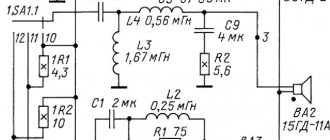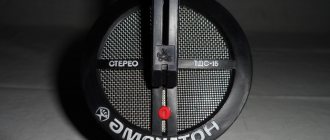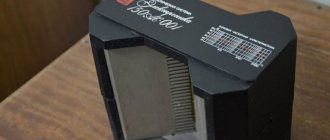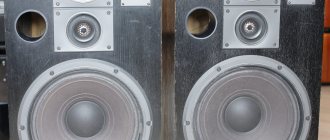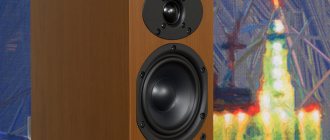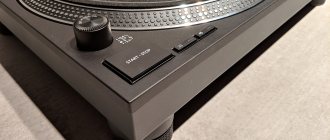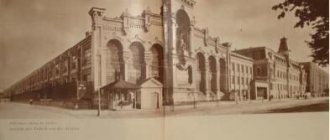The three-way speaker system 35AC-1, developed about ten years ago at the Orbita design bureau of the Riga production association Radiotekhnika, can, without exaggeration, be called the founder of a family of speakers that made high-quality sound reproduction a reality at home. At that time, 35AC-1 was the best not only among domestic household loudspeakers, it sounded better than many speakers from foreign companies.
Rice. 1. Appearance of the Radiotekhnika 35AS-1 speakers
In 1979, based on the 35AC-1 (the crossover filter and the front panel of the acoustic design were changed), the 35AC-212 (S-90) was created, which is currently produced by several enterprises under the names 35AC-012 and 35AC-016. Unfortunately, today these speakers no longer satisfy the increased demands of high-quality sound lovers.
Characteristics of 35AS-1
- Reproducible frequency range in free field conditions, Hz: 25–25000
- Uneven frequency response of sound pressure, dB, at the lower limit frequency of the reproduced frequency range relative to the average sound pressure level: -15
- Uneven frequency response of sound pressure, dB, in the frequency range 100… 8000 Hz relative to the average sound pressure level: ±4
- Level of characteristic sensitivity (characteristic sensitivity), dB (Pa/√W), not less than: 85 (0.338)
- Directional characteristics of the speaker, dB, determined by the deviation of the frequency response of sound pressure, measured at angles of 25±5° in the horizontal plane and 7+3°-2° in the vertical plane, from the frequency response measured along the acoustic axis of the speaker (0°):
- in the vertical plane: ±8
- in the horizontal plane: ±6
- Harmonic distortion of speakers, %, determined by the total characteristic harmonic coefficient at an average sound pressure level of 90 dB at frequencies, Hz, no more than:
- 250…1000: 2
- 1000…2000: 1.5
- 2000…6300: 1
- Nominal electrical resistance (nominal value of total electrical resistance), Ohm: 4/8
- Minimum value of total electrical resistance, Ohm: 3.2 / 7.6
- Rated power, W: 35
- Maximum noise (nameplate) power, W: 70
- Maximum short-term power, W: 600
- Weight, kg: 27
- Dimensions, mm: 360x700x280
- Internal volume of the speaker housing, dm3: 45
- HF head: 10GD-35-300
- Midrange head: 15GD-11-120
- LF head: 30GD-1-25
- Type of low-frequency acoustic design: bass reflex
- Bass reflex cross-section dimensions, mm: 100x80
- Bass reflex tuning frequency, Hz: 25
- Crossover frequencies provided by low-midrange filters. Hz: 750±50
- Crossover frequencies provided by MF-HF filters. Hz: 5000±50
Soviet HI-FI and its creators: 35AC-1, S-90, Kerno and the first Soviet HI-FI
So, perhaps the most legendary and most controversial product of the Soviet HI-FI industry is the 35AC-1 speaker system (better known to the general public as the S-90). This was the first Soviet speaker that reached the HI-FI level and became a kind of symbol of high-quality Soviet audio equipment. Moreover, it was the first serial audio component in the USSR that complied with the DIN 45500 standard, the next was the Brig amplifier.
It is also interesting that the creator of this “cult” system was the real patriarch of Soviet and Latvian acoustics, Roland Kerno, who gained valuable experience at the Telefunken enterprises during the war years.
Among other things, the history of the creation of the S-90 is connected with modern myths, which are spread by one of the supposedly former employees of the Radiotehnika plant. I will dwell on this myth separately, since through the efforts of this man, half of the RuNet accepts him as the creator.
Wartime legacy
As is known from history, in 1941 it became part of the large German production association “Telefunken”.
At “Radiotekhnika” at that time they dealt exclusively with military orders, repairing radio transmitters, radio receivers, optical equipment and loudspeakers. During that difficult period for Latvia and the world, a young engineer, Roland Kerno, worked at the company, who would later create the first HI-FI class acoustic system in the USSR. It is believed that valuable experience in one of the best wartime engineering companies in Europe had a significant impact on the thinking of the young engineer. According to the recollections of Likhnitsky, who in one of his publications mentioned a conversation with Kerno, it is known that he was involved in the creation of 300 mm loudspeakers and acoustic systems for radios. Among other things, Lichnitsky mentioned that Roland Paulovich managed to learn several technological secrets related to the diffusers of German speakers (I would not rush to make the information from his article the truth in the first instance, given Lichnitsky’s love for hoaxes).
Some biographical information
After receiving a certificate of secondary education, Roland entered the technical faculty of the Latvian State University.
During the years of occupation, as I already wrote, a graduate of the Riga University worked at the enterprise “Telefunken Geratewerk Riga”, which then acquired the now famous name “Radiotehnika”. After the end of the occupation, Roland Paulovich continued to work at the same enterprise as a Soviet engineer. At that time, the future creator of the S-90 could, without exaggeration, be called a man of his time. His engineering and design electroacoustic solutions often anticipated the inventions of Western engineers. Unlike many Soviet developers, Kerno did not repeat already created samples, but developed either a fundamentally new technology, or simply original and not inferior to foreign analogues.
In the early 60s, Roland proposed using a multi-band frequency division design using a passive filter to achieve high fidelity. Such systems were practically never produced in the USSR, and in the West, mainly broadband ones were used. This is one of many innovative solutions that will find its application in both Soviet and Western mass products already in the 70-80s.
With his fundamental knowledge and bold technical solutions, Kerno earned the unspoken title of patriarch of Soviet electroacoustics. He quickly became one of the leading developers of audio equipment at the Orbita Design Bureau, which was part of the RRR Radiotehnika VEF software.
Prerequisites for the appearance of S-90
As in the case of the first Hi-Fi amplifier, this speaker system could not appear on sheer enthusiasm.
What was needed was the will of the leadership, etc. planned necessity. This need arose in 1975. At the exhibition “Communication 1975” the radiogram “Victoria 003” and the electrophone “Allegro 002” were presented. The presented samples were being prepared for release over the next 2 years. A problem arose with serial production: there was no decent acoustic system for the radio and record player that could reveal their capabilities. The main criterion for the new speaker system was to be power. The technical specifications for the developers included a nominal value of 35 W for each channel (i.e., about 100 W RMS).
The creation of such a system was entrusted to the Orbita Design Bureau. Kerno took advantage of the situation and included new requirements for the HI-FI standard in the terms of reference for acoustics. Having received several patents for electroacoustic inventions by that time, Kerno decided to apply his achievements to create speakers with high (by Soviet standards) fidelity.
First steps - 35AC-1
As a result of an intense creative process, thanks to the intensive and well-coordinated work of the Orbit team under the leadership of Kerno, 35AC-1 was created in 1977. In fact, these are the same S-90, only with a slightly different design. It was this speaker that became the first system that complies with the Hi-FI standard. The authors of the project were Kerno Roland Paulovich and Lasis Dzintars Arturovich.
To ensure sufficient sound pressure, a bass-reflex acoustic design of the housing was chosen, and in order to dampen parasitic resonances from the midrange and high-frequency speakers, they were placed in separate closed volumes.
It has become quite modern to place the bass reflex hole on the front panel of the case, which allows saving space when placing speakers. The system was equipped with loudspeakers LF: 30GD-1-25, MF: 15GD-11-120 and HF: 10GD-35-3000.
One of the interesting and characteristic features of the acoustics is the step-by-step playback level controls for midrange and treble. The controls made it possible to change sound pressure and timbral characteristics in the ranges from 500 to 5000 Hz and from 5,000 to 20,000 Hz. Each control block had three fixed positions: 0dB, -3dB and -6dB. So, in the “0 dB” position, the signal from the filter was immediately fed to the dynamic head, and in other positions it passed through the corresponding resistor, which attenuated it, thus determining the frequency and timbre features of the sound.
The best speaker in the USSR in the 70s
The characteristics of the system were better than those of all household models produced by the USSR at that time. Many authors who are well acquainted with Western speakers of that period say that this Soviet development was superior to some examples of similar equipment from the USA and Europe, definitely second only to Japanese developments.
- Nameplate power - 90 W.
- Rated power - 35 W.
- Nominal electrical resistance is 4 ohms (8 ohms).
- Reproducible frequency range - 31.5...20000 Hz (+-4 dB).
- Nominal sound pressure - 1.2 Pa.
- Harmonic distortion of speakers at a sound pressure level of 90 dB at frequencies: 250 – 1000 Hz: 2% 1000 – 2000 Hz: 1.5% 2000 – 6300 Hz: 1%
- Overall dimensions of the speakers are 360x710x285 mm.
- Speaker weight - 30 kg.
This frighteningly humpbacked frequency response graph for Soviet technology of the 70s was an unattainable standard.
Two years later, the 35AS-1 with a modified design began to be produced by the Radiotekhnika plant as an independent product called S-90. There were no significant changes in the acoustic characteristics of the S-90 - it was almost the same speaker with a new name. Later versions of the speakers “S-90B” and “S-90D” were distinguished by an increase in the frequency range, the presence of an indication of electrical overload of the loudspeakers and a new updated cabinet design.
The joy and curse of the Soviet music lover
Like any other system, the 35AC-1 was not without its shortcomings. Picky audiophiles often complain about the droning nature of the lows, unnatural sound reproduction and the uselessness of timbral filters when the system is poorly coupled with an amplifier.
Experts note the imperfection of the filter design.
Meanwhile, the high power of the speaker (which attracted many to this system) and the inherent simplicity of design in Soviet technology left experienced radio amateurs with the opportunity for modifications and improvements.
An unexpected “creator”
Decades passed, production of the legendary system ceased in the early nineties, and everyone completely forgot about those who created it.
In Latvia, of course, they remembered that Roland Kerno continued his creative path as an engineer almost until the moment of his death, and became a member of the Latvian Acoustical Society. The engineer died in 2003. But in Russia, where the lion's share of the S-90 was supplied before the collapse of the USSR, they forgot about it. So in 2014, a video filmed by the TV company “Expert TV” appeared on the channel of the Alex Audio company, in which a certain member of the Russian Academy of Natural Sciences, Alexander Yan-Belyaevsky (founder of the Alex Audio company), is called the author of the S-90 acoustic system. They say the speaker system was developed in the 80s, when Yan-Belyaevsky allegedly worked at the Radiotekhnika plant.
There is no information online that he actually worked there. In addition to this story from Yan-Belyaevsky himself, here is a quote where he mentions that it was he who developed the filter for the S-90:
“In the distant and cloudless year of 1975, 35AC - 35 W acoustics were sold everywhere in the USSR.
(according to international standards 70 W), which was produced by all factories and the Riga Popov Factory was no exception... Acoustics can also be done by ear. “How it really was!” says the author of S-90At that time I was 14 years old, I was studying in a radio engineering club in Kozhukhovo, Avtozavodskaya metro station, under the guidance of Pavel Ikonnikov. My parents were familiar with the chief engineer of the Riga plant - Tsudechkis - “He was smart about everything,” “An enterprising person - he introduced everything new and new, and the whole plant depended on him!” For myself, for my home, I made an acoustic system, using the Riga speakers as a basis - “Tsudechkis saw it at my house!”, the first thing he said: “This is exactly what I need - I have a whole design bureau ( The design bureau) is subordinate, but it’s all to no avail!“ Acoustics can also be done by ear. “How it really was!” says the author of S-90
“All over the world, I am considered the founder of the S-90 speaker prototype, which was created in 1979 and put into production in 1980.” We went to Riga to the plant, went into all the departments: engineers, designers, technicians. Tsudechkis gave the order: “This guy, whatever he says, do it!” And everything worked out, imagine - I was 14 years old, they drew, wrote, calculated, made “my” filters... The prototype was ready! Acoustics can also be done by ear. “How it really was!” says the author of S-90
-At first, everything was assembled from scratch - I assembled filters without focusing on measurements, and now the long-awaited moment - the S-90 was placed in the sound chamber and Tsudechkis’s calculations were completely justified - Almost a perfect schedule, “You all know it,” everyone was shocked ! I understood one thing: “Acoustics can be done by ear!” In addition to the S-90, I developed the S-30 speakers, and all new models were immediately put into production. They gave me a pair of S-30s, and I went back to Moscow.”
(author's typography preserved, based on materials from nnm2.com/blogs/etam)
Yan-Belyaevsky also signs quite pathetically:
Always yours - Inventor of S-90. Sincerely, Member of the Russian Academy of Natural Sciences General Director of the Company “ALEKS” Yan-Belyaevsky Alexander Vladimirovich
Interestingly, Yan-Belyaevsky himself was born in 1965. Those. He allegedly developed the 35AS-1 at the age of 11. By the way, in 1978 (01/15/1978) the Orbita Design Bureau received patent No. 00588661 for the development of the 35AC-1 (S-90) acoustic system. The authors indicated in the patent are Kerno Roland Paulovich and Lasis Dzintars Arturovich, which completely excludes the possibility of any relationship between Yan-Belyaevsky and this development in the 80s.
Bottom line
To this day, many not very sophisticated music lovers use the C-90 as home acoustics.
There are also collectors for whom these Soviet speakers of different series are of collection value. Russian speaker manufacturers, including Aleks Audio and Arslab, make nostalgic S-90 clones. Enthusiasts with hands in the right place and knowledge in acoustics regularly post options for alterations of the famous legend of Soviet speaker construction. The creator of this speaker, Roland Kerno, of all post-war engineers, made perhaps the most impressive contribution to Soviet electroacoustics. He patented more than 10 inventions and developed almost all acoustic systems produced since the 1940s, which is about 30% of all models of acoustic systems produced in the USSR after 1940.
The engineer's contemporaries said the following about him:
This is a unique person; all the “acoustics” that Radiotekhnika has produced since the late 40s were developed by him. He was one of the first to come up with the principle itself: taking several speakers responsible for a narrow frequency band and separating them with special filters. But Roland Paulovich believed that it was impossible to collect such comprehensive information as to make everything predictable on paper. There will always be some moment of creativity in this work...
Jeans
Our catalog presents a wide range of high-fidelity acoustic systems.
Housing 35AC-1
The enclosures of all modifications of the speakers are made in the form of a rectangular non-dismountable box made of chipboard veneered with valuable wood veneer. The thickness of the case walls is 16 mm, the front panel is plywood 22 mm thick. At the junctions of the housing walls and on the inside, elements are installed that increase the strength and rigidity of the housing.
Rice. 3. Design of speakers Radiotekhnika 35AS-1. Front view. 1 - latch for decorative panel; 2 - woofer head; 3, 4 — volume controls for the middle and high frequencies of the signal; 5 - HF head; 6 — midrange head; 7 - bass reflex port.
Rice. 4. Diagram of the Radiotekhnika 35AS-1 speakers. Side view. 1 — connecting cord plug; 2 — back wall of the box; 3 — filter block; 4 — cover of midrange and treble heads; 5 - wooden angles to increase the rigidity of the box; 6 - HF head; 7 - decorative false panels; 8 — foam plastic pad; 9 — midrange head; 10 - front board; 11 — woofer head; 12 — decorative panel; 13 - bass reflex; 14 - supports.
Schematic diagram
The circuit diagram and arrangement of parts on the filter board, given in the description of the speaker, are shown in Fig. 1 and 2, respectively (element C3 is excluded). Capacitors C1, C2, C4-C7 - MBGO-2, C9, C8 - K73-11. The filter elements are mounted on a board measuring 210x160 mm made of 12 mm thick plywood.
Inductors L1-L4 are installed on the board in a position in which their magnetic coupling can significantly affect the quality of sound reproduction. The filter itself is mounted on the rear wall inside the speaker housing behind the woofer head. Circuit elements marked with the prefix 1 are located outside the crossover board.
Rice. 1. Circuit diagram of speakers 35AC-012 (radio equipment S-90).
Rice. 2. Location of parts on the speaker filter board 35AC-012 (radio equipment S-90).
Modification of 35AS-1
As studies conducted at the Department of Radio Broadcasting and Electroacoustics of the Moscow Electrotechnical Institute of Communications (MEIS) have shown, the weakest link of the AC is the mid-frequency dynamic head 15GD-11 A. The frequency response of this head has a sharp decline above 4.5 kHz, which practically eliminates the possibility of obtaining “ bright”, “transparent” sound in the mid-frequency region.
It also has another drawback - the large mass of the moving system, which, however, can be successfully combated by introducing acoustic damping [1]. The 10GD-35 high-frequency head is not without its shortcomings. The main one is the high resonance frequency of the moving system. A crossover filter with a cutoff frequency of 5 kHz is not able to attenuate signal components whose frequency coincides with the resonant one, and this gives rise to many unpleasant overtones.
The sound quality of speakers can be significantly improved by eliminating the reasons that worsen it, i.e., replacing the 15GD-11A head with a 5GDSh-5-4 broadband head (former designation 4GD-53) and increasing the separation frequency of the mid- and high-frequency bands from 5 to 10 kHz. After such modification, the rated power of the speaker is reduced by approximately half, so it can only be used with an amplifier whose rated output power does not exceed 50 W (per channel).
However, as practice shows, this is quite enough to obtain high-quality sound reproduction in any living room.
The choice of the 5GDSH-5-4 broadband head is not least due to the identity of its installation dimensions with the 15GD-11A head, which makes replacement easier and allows you to keep the appearance of the speaker intact.
To improve the parameters of the 5GDSH-5-4 head, it is necessary to coat part of the upper suspension of the diffuser with non-drying vibration-absorbing mastic [2] and equip it with an acoustic resistance panel, sealing the windows of the diffuser holder with synthetic felt (TU 17-35-3941-81) or other suitable material [1] .
Let's look at the modernization procedure using the 35AS-016 system as an example. Putting it with the back wall down, unscrew the screws, remove the decorative trims, remove the 15GD-11A and 30GD-1 heads and, through the hole for the last one, remove the separation filter board. Since the thickness of the diffuser holder flange of the new head is much thinner, it is necessary to place an annular gasket under it, cut exactly to the dimensions of the flange made of porous rubber with a thickness of 8...10 mm.
To avoid touching the diffuser and the protective mesh, you should put M5 nuts on the screws (between the head and the decorative cover) - they will tightly press the head to the mid-frequency head box and, in addition, will prevent deformation of the covers under the action of the screws.
Connect the 5GDSH-5-4 head in the same polarity as the 15GD-11A. To equalize the sensitivity and match the 5GDSH-5-4 head with the isolation filter (Fig. 5), resistor R' is connected in series with it (shown in the diagram with dashed lines), which is fixed on the filter board.
Rice. 5. Acoustic filter Radiotekhnika 35AS-11
Changes in the filter are as follows (positional designations of elements whose values change during modification are provided with strokes). Having unsoldered the leads of coil L4 (0.56 mH), it is removed, and coil L1 (0.22 mH) is installed in the free space, which is included in the filter instead of L4 (this increases the upper limit of the operating frequency band of the mid-frequency head).
Then they unwind 115 turns from coil L4 (the new inductance is 0.1 mH) and, installing it on the board, connect it instead of coil L1. Capacitor C1 (2 μF) is replaced by capacitor C2 (1 μF), and instead of the latter, a paper capacitor with a capacity of 0.5 μF is included. After this modification, the cutoff frequency of the high-frequency filter section increases to 10 kHz.
To evaluate the effectiveness of the proposed modification to the 35AC-1, it is recommended to first remake one speaker and compare its sound with one that was not converted in monophonic mode. The assessment will be more objective if listeners do not know which speaker has undergone modernization, and will determine it by their sound preference. It is necessary to switch the speakers quickly (for example, using a toggle switch), and it is advisable to do this several times while listening to the same piece of music.
The frequency characteristics of the speakers before (dashed line) and after modification (solid line) are shown in Fig. 6. As you can see, the result of the refinement is manifested in a slight decrease (from K) to (1 dB) in the unevenness of the characteristics in the mid-frequency region. Comparative listening showed a clearly noticeable preference for the sound of the converted speaker.
Rice. 6. Frequency response of the Radiotekhnika 35AS-1 acoustics after modernization
